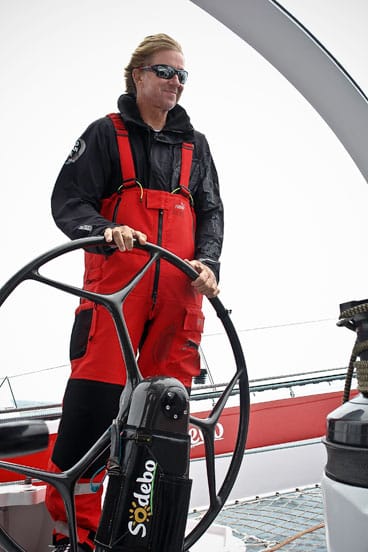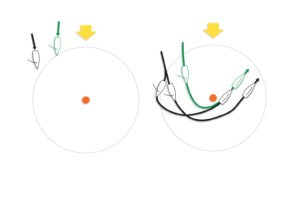
Ken Read driving
I’ve spent the last six years living, working, sailing, and selling the Volvo Ocean Race. I’m part of the family, now. It’s in my blood. And that’s why I’m involved both physically and emotionally with decisions involving its future. I can tell you this: If this race is to carry on, it needs more entries. It is that simple.
To attract more entries, the overall cost to compete must come down. Not just a little down, but 25 percent down. I know the powers-to-be in the Volvo Ocean Race have been working hard on reducing the cost of entry. Knut Frostad [the race’s CEO] told me specifically that the Volvo Ocean Race Board of Directors gave him a mandate on the number of boats for the next race. If he fails to fulfill that mandate, there may not be another Volvo Ocean Race. So what to do?
My first inclination was to give it another go with the Volvo Open 70. The race’s DNA is in the Volvo Open 70. I’ve spent a lot of time on these boats. They’re awesome, brutal machines. When we pull into the harbor—any harbor—the fleet turns heads. Sponsors love them because they are incredible platforms for sponsor days, and fabulous floating billboards. And, because they’re custom built, teams can utilize home country expertise and employment—which is often another key criteria for a sponsor. The sailors love them because they separate the men from the boys.
So when I first heard that race organizers were considering a one-design for the next race, I cringed. There were all kinds of rumors floating around, including one about a dumbed-down monohull similar to the old Whitbread 60, with fixed keels and water ballast. That, for sure, would’ve been a huge mistake. High performance is crucial when you are talking about the best of the best, especially if we’re to deliver the type of jaw-dropping footage that the media crewmembers delivered during the most recent lap. Then there was talk of hybrid canting-keel boats, simplified and quite a bit slower than the current class, and even talk of multihulls like the current fleet of MOD70s. But the race’s decision makers correctly identified that the VOR is a monohull race. Completely changing that part of the DNA was of no interest to them. Besides, who would ever be crazy enough to change a successful monohull event into a multihull event? (Said with a wink.)
In the sailmaking business, which was my life before I got into this race, we were always taught that it is far easier—and more cost effective—to keep one’s current clients than it is to create new ones. And with that in mind, the race’s current stakeholders (the six heads of the teams competing in the 2011-’12 edition) sat down several months ago to discuss changes to the race.
It became apparent early on that the Volvo Ocean Race Board cherishes the race and wants to ensure its longevity. They’re willing to invest in the tooling for a one-design boat, and pre-fund the building of a minimum of eight boats for the 2013-’14 edition.
Knut knew I was a supporter of the Volvo Open 70 and asked me whether I could guarantee at least eight VO70s in the next race, and, of course, I could not. The advance funding would all but guarantee eight entries next time, so it was clear to me there was no other option.
With a commitment to going one-design, the next step was to develop the boat itself. The latest VO70s are some of the fastest monohulls on the ocean. But they are products of a 10-year-old box rule, so surely there could be a slightly smaller and more cost-effective boat built of similar speed and pedigree as the 70s.
And this is where we (the stakeholders) really got management rolling on ways to speed up a 65-footer enough to give it the potential to break the 24-hour monohull record. The new design should have a lot of the bells and whistles the current 70s do, yet have cost savings in simplification, duplication, and reduced build time. Once the sailors found out that a “Speed Group” had been assembled, quite a few came forward with a lot to say about the design of this new rocket.
The big question, however, is whether VOR management will listen. They have the ultimate say, but if they want buy in from the best sailors in the world, they had better listen to the best sailors in the world. In effect, this is no different than the way teams are run now: The sailors make more effective decisions about the boats because they are the ones that have to sail them. If the boats aren’t exciting, the best sailors will walk away.
Farr Yacht Design earned the right to design the 65-footer, which will be the staple of the next two Volvo Ocean Races. Farr Yacht Design was chosen because they have a long history with the race, and according to Frostad, they pushed the hardest for the job. Juan Kouyoumdjian, who designed the last three winners, was approached, but simply didn’t agree with a one-design concept. He offered to them the current plans from Telefonica or PUMA to be the next one-design, but race management wanted a slightly smaller and more cost-effective boat. Maybe Kouyoumdjian has enough on his plate designing the AC72 for the Artemis Racing America’s Cup syndicate.
One curious move by Volvo, however, was to involve a consortium of four European builders to share the responsibility of building the boats and components, and completing the assembly. Decision Boatyard, in Switzerland, will build the bulkheads and internal structural elements. Persico, in Italy, will mold the hulls and lay the longitudinal stiffeners. Multiplast, in France, will build the decks and fit them out before sending them to Green Marine, in the United Kingdom, which will finish and launch the boats.
These are not the cheapest builders in the world, so whether this will actually save money compared to the current fleet of 70s is open for debate. Some of the cost numbers being thrown for this 65-footer aren’t all that much less than what I think a new 70 could be built for with some simplification. There will, however, be savings on design and duplication of spare parts and components.
But the bottom line, no pun intended, is that for the race to continue, commercial and competitive requirements must be met. The VOR Board has the keys to the car, and if they want to park it in the garage, they will. If they want you to sail around in a SUV, they will. Fortunately, it looks like this race will continue to be sailed in Formula 1, and crews will have an even larger influence on the outcome than in the past. Development will be concentrated in the sail and rig packages. And on the racetrack, those who can hang it out longer without breaking will come out on top. Even if these 65-footers are the best engineered boats on the planet, the sailors will break them. The ocean will break them.
Long live the Volvo Ocean Race, and thanks to the Board for stepping up and putting their money where their mouth is. Now it’s up to VOR management to continue to listen to the sailors.
Read more from Ken Read’s column, Gaining Bearing, here.
Read more about the Volvo Ocean Race here.









